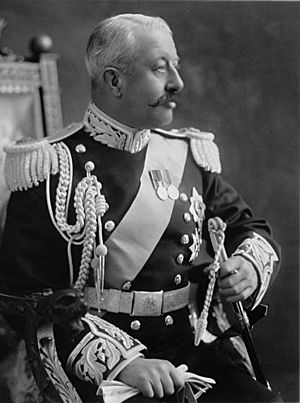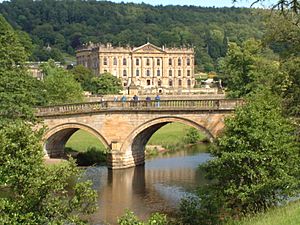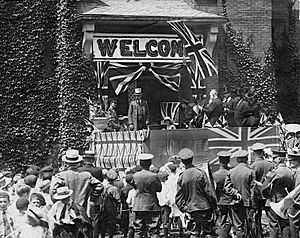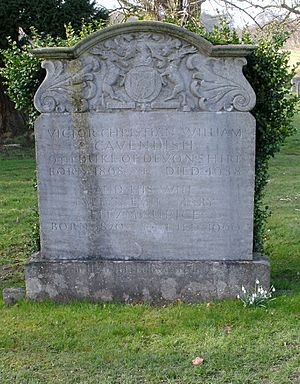Victor Cavendish, 9th Duke of Devonshire facts for kids
Quick facts for kids
The Duke of Devonshire
|
|
|---|---|
 |
|
| 11th Governor General of Canada | |
| In office 11 November 1916 – 2 August 1921 |
|
| Monarch | George V |
| Prime Minister | Canadian • Robert Borden • Arthur Meighen British • H. H. Asquith • David Lloyd George |
| Preceded by | Prince Arthur, Duke of Connaught and Strathearn |
| Succeeded by | The Lord Byng of Vimy |
| Secretary of State for the Colonies | |
| In office 24 October 1922 – 22 January 1924 |
|
| Monarch | George V |
| Prime Minister | Bonar Law Stanley Baldwin |
| Preceded by | Winston Churchill |
| Succeeded by | James Henry Thomas |
| Civil Lord of the Admiralty | |
| In office 25 May 1915 – 26 Jul 1916 |
|
| Monarch | George V |
| Prime Minister | H. H. Asquith |
| Preceded by | George Lambert |
| Succeeded by | The Earl of Lytton |
| Financial Secretary to the Treasury | |
| In office 9 October 1903 – 5 December 1905 |
|
| Monarch | Edward VII |
| Prime Minister | Arthur Balfour |
| Preceded by | Arthur Elliot |
| Succeeded by | Reginald McKenna |
| Treasurer of the Household | |
| In office 4 December 1900 – 13 October 1903 |
|
| Monarch | Victoria Edward VII |
| Prime Minister | The Marquess of Salisbury Arthur Balfour |
| Preceded by | The Earl Howe |
| Succeeded by | Marquess of Hamilton |
| Member of the House of Lords Lord Temporal |
|
| In office 24 March 1908 – 6 May 1938 Hereditary Peerage |
|
| Preceded by | The 8th Duke of Devonshire |
| Succeeded by | The 10th Duke of Devonshire |
| Member of Parliament for West Derbyshire |
|
| In office 2 June 1891 – 24 March 1908 |
|
| Preceded by | Lord Edward Cavendish |
| Succeeded by | Earl of Kerry |
| Personal details | |
| Born | 31 May 1868 Marylebone, London, England |
| Died | 6 May 1938 (aged 69) Chatsworth House, Derbyshire, England |
| Political party | Liberal Unionist |
| Spouse |
Lady Evelyn Petty-Fitzmaurice
(m. 1892) |
| Children |
|
| Parents |
|
| Alma mater | Trinity College, Cambridge |
| Profession | Politician |
Victor Christian William Cavendish, 9th Duke of Devonshire (born May 31, 1868 – died May 6, 1938) was an important British politician and nobleman. He was known as Victor Cavendish until 1908. He served as the Governor General of Canada, representing the British monarch in Canada.
He came from the famous House of Cavendish family. He went to Eton College and the University of Cambridge. After his father passed away in 1891, Victor started his political career. He won his father's old seat in Parliament without anyone running against him. He kept this seat until 1908, when he inherited his uncle's title and became the Duke of Devonshire. This meant he then joined the House of Lords. For a while, he was also the mayor of Eastbourne and Chesterfield.
In 1916, King George V chose him to be the Governor General of Canada. This was a big job! He stayed in this role until 1921. At first, some people weren't happy about his appointment. But by the time he left Canada, he had earned a lot of praise for how well he did his job. After being Governor General, he continued his political work. He was the Secretary of State for the Colonies from 1922 to 1924. He then retired to his home in Derbyshire, where he passed away in 1938. He was the last Duke of Devonshire to hold a position in the British government's Cabinet.
Contents
Who Was Victor Cavendish?
Victor Cavendish was born in Marylebone, a part of London, England. He was the oldest son of Lord Edward Cavendish. His mother was Emma Lascelles. His uncle was Spencer Cavendish, 8th Duke of Devonshire, who later became the eighth Duke.
Victor went to Eton College, a famous school, and then to Trinity College at Cambridge. While at Cambridge, he joined the Derbyshire Yeomanry, a part-time military group. He became a second lieutenant in 1890 and later a major. He left the Yeomanry in 1911.
Victor's Family Life
On July 30, 1892, Victor Cavendish married Lady Evelyn Petty-FitzMaurice. Her father had been the Viceroy of India and also a Governor General of Canada. Victor and Evelyn had seven children together:
- Edward William Spencer Cavendish, who became the 10th Duke of Devonshire.
- Lady Maud Louisa Emma Cavendish.
- Lady Blanche Katharine Cavendish.
- Lady Dorothy Evelyn Cavendish, who married Harold Macmillan, who later became a British Prime Minister.
- Lady Rachel Cavendish.
- Lord Charles Arthur Francis Cavendish.
- Lady Anne Cavendish.

Starting His Political Journey
In May 1891, just before Victor finished university, his father passed away. His father had been a Member of Parliament (MP) for West Derbyshire. Victor decided to run for his father's old seat in Parliament and won. This made him the youngest member of the British House of Commons at that time.
Victor worked as an MP for seventeen years. During this time, he held several government jobs:
- From 1900 to 1903, he was the Treasurer of the Household.
- From 1903 to 1905, he was the Financial Secretary to the Treasury.
- In 1905, he became a member of the Privy Council, a group of advisors to the King.
In 1908, Victor inherited his uncle's title and became the Duke of Devonshire. This meant he could no longer be an MP in the House of Commons. Instead, he took his place in the House of Lords. The same year, he became the Lord Lieutenant of Derbyshire. He also served as the Chancellor of the University of Leeds. He was even elected mayor of two towns: Eastbourne (1909-1910) and Chesterfield (1911-1912).
During the First World War, the Conservative party joined the government. Victor served as the Civil Lord of the Admiralty, which was a role in the British Navy.
Serving as Governor General of Canada

On August 8, 1916, it was announced that King George V had chosen Victor Cavendish to be his representative in Canada. This job is called the Governor General. The appointment caused some issues because the Canadian Prime Minister, Robert Borden, was not asked about it first. This was unusual and made things a bit difficult for Victor at the start. He officially began his role on November 11, 1916, in Halifax.
During this time, Canada was facing many challenges. The women's suffrage movement (women fighting for the right to vote) was growing. People in the prairies wanted changes to the government. Also, the First World War was still happening. Canada was sending many soldiers and supplies to help. Soon after Victor arrived, he helped introduce conscription, which meant people had to join the military. This decision caused a lot of disagreement, especially between French and English Canadians. This led to the Conscription Crisis of 1917.
In 1917, a huge explosion happened in Halifax. Victor traveled there to see the damage and meet with people who survived. He also spoke to women who were volunteering to help.
A big moment for Canada was the victory at the Battle of Vimy Ridge in 1917. This battle helped Canadians feel more proud of their country. Victor used this feeling to encourage French and English Canadians to work together. He always made sure to talk with the Canadian Prime Minister and other leaders about important decisions, especially those about the war.
Victor cared about Canadians and traveled a lot to meet them. He was very interested in farming and visited many farms and agricultural shows. He often talked about how Canada could become a world leader in farming. One of his main goals was to set up experimental farms, including a big one in Ottawa. He also supported the arts. He visited the National Gallery and hosted plays at Rideau Hall, the official residence. In winter, he and his family hosted fun parties with tobogganing, skating, and hockey games.
In 1918, Victor visited the United States to meet President Woodrow Wilson. The next year, he hosted Prince Edward, Prince of Wales, who was visiting Canada for the first time.
By the end of his time as Governor General, Victor had won over everyone. Both Canadian Prime Ministers he worked with, Robert Borden and Arthur Meighen, became his friends. Borden said that Victor understood public issues very well, not just in Canada but across the entire British Empire. Victor left behind the Devonshire Cup for a golf competition and the Duke of Devonshire Trophy for a gardening society.
Later Career and Retirement

After returning to England, Victor Cavendish worked with the League of Nations, an organization that aimed to promote peace. From 1922 to 1924, he served as the Secretary of State for the Colonies. This was a very important job, and he was part of the government's Cabinet.
In this role, he disagreed with some white settlers in Kenya who wanted to rule the country themselves. Victor believed it was important to protect the interests of the Africans living there. He wrote a document called the Devonshire White Paper in 1923. This paper helped ensure that Kenya did not become a country ruled by a white minority, like South Africa or Southern Rhodesia.
He continued to manage his large farming estates, especially around Chatsworth House. He passed away there in May 1938.
Honours and Recognition
Victor Cavendish received many honours throughout his life for his service. He was made a Knight of the Garter, which is a very high honour in the United Kingdom. He also received the Knight Grand Cross of the Royal Victorian Order and the Knight Grand Cross of the Order of St Michael and St George.
Several places and awards are named after him:
- In Canada, there is the Devonshire Cup for golf.
- In Ontario, there is the Duke of Devonshire Trophy for horticulture.
- A school in Ottawa, Ontario, is called Devonshire Community Public School.
- A street in Imperial, Saskatchewan, is called Devonshire Crescent.
See also


